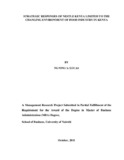| dc.description.abstract | The environment is constantly changing .Organizations have to be proactively or continuously adopt their operations in order to survive the environmental challenges. The environment provides the firms with opportunities, Threats and constraints, but rarely does a single firm exert any meaningful reciprocal influence. The liberalization of the economy, Privatization, increased competition the general economic reforms in all sectors are some of the changes that exist in the operating environment. The environment is highly dynamic and continuously presents opportunities and challenges. To ensure survival and success, Firms need to develop capabilities to manage threats and exploit emerging opportunities promptly. The strategies that match the capabilities to the environment are required. The goal of this is to analyse and understand the critical factors to take into account when responding to the challenges in the environment. The scope of this research was limited to Nestle Kenya with special emphasis on how it has operated in Kenya for over 40 years. The research design investigated the relationships between the challenges and specific responses applied by the company. The challenges and strategic responses adopted were analysed through narrations, the data collected with the help of an interview guide and a face to face interview conducted, content analysis used to bring out the findings. The secondary data came from the company's past reports and intranet.
Over the years, Kenya has adopted different economic policies since independence most of which had a lot of impact on the manufacturing sector. Between the year 1963 and 1979, the government adopted import substitution policy aimed at protecting the local infant industries. However the global events led to change in the policies in 1970‟s - the breakup of East African community and sharp drop of oil prices in the world market resulted in a balance of payment problems leading to structural adjustment program policies between 1980 to 1994 focusing on opening the economy to external trade. In 1995 Kenya ratified world trade organization agreement the further opened the economy to the global market. The changing economic policies have led to different environment for manufacturers like Nestlé Kenya that has been operational in Kenya since 1967.
viii
The research revealed that these were some of the strategic responses Nestle Kenya took to see it through the changes during its years of operation in Kenya as a wholly owned subsidiary of Nestle group of companies. On realizing that it was keeping a lot of its capital on a function that is not the company‟s core business, it decided to outsource tins from another manufacturing company and sold off her plant for tin and invested in more food manufacturing and packing machines. With the competition growing over the years, Nestle Kenya saw an opportunity to diversify the range of products that it produces and even imported into the Kenyan market to have a competitive edge over the competition. Being a multinational organization, the company has benefited a lot from its employees from other developed markets all over the world. The company has developed and continues to invest in information technology that does not only link it to the other companies but to their customers too. The scope and depth of the study was limited by time and the study recommended that although Nestle Kenya Limited has been successful in neutralizing the challenges brought about by changes in the environment, The Company should engage in producing more affordable small packs for the mass market. | en_US |



